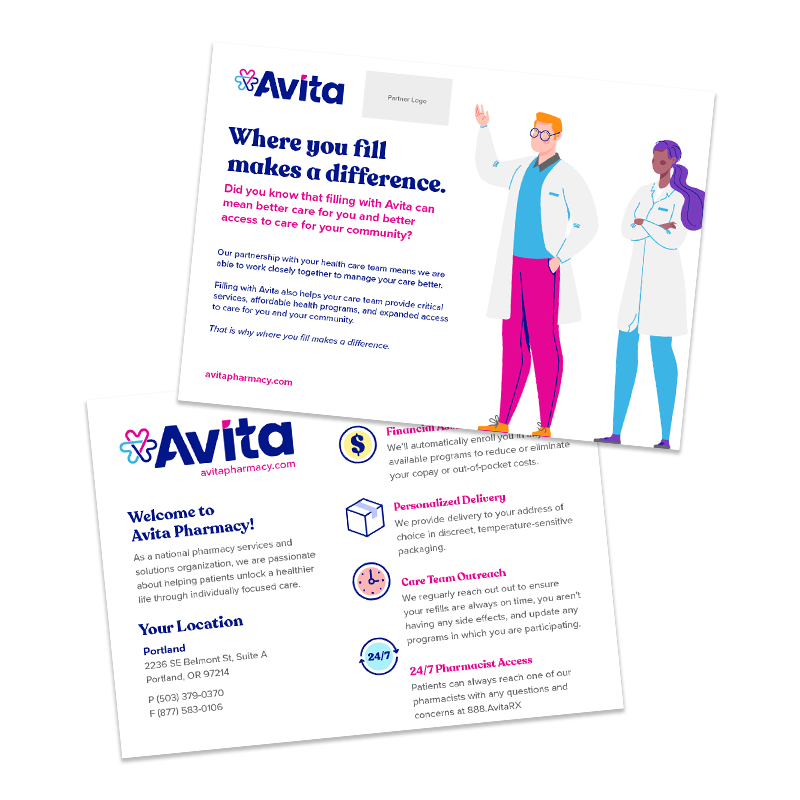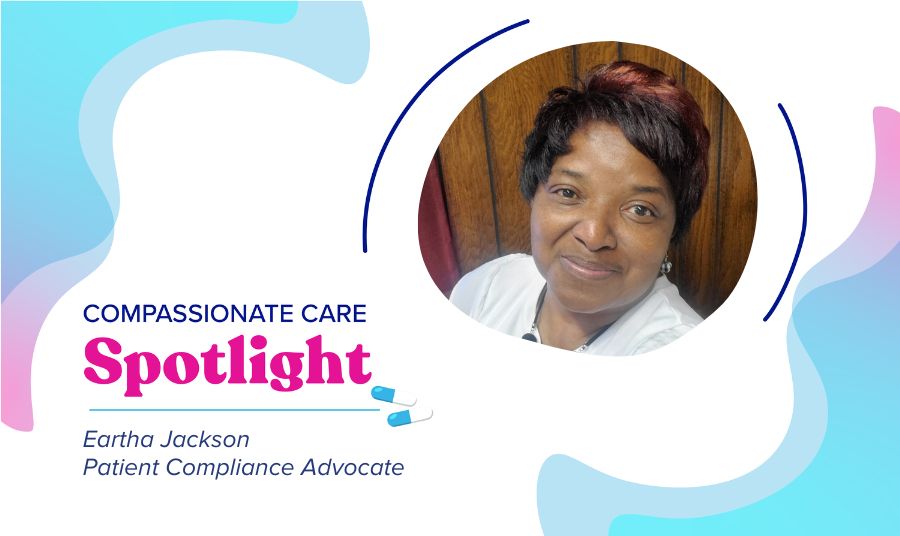Saving people’s lives.
Eliminating the stigma surrounding a host of physical and mental health conditions.
Advocating for the health equity of underserved populations.
Executing targeted marketing campaigns.
One of these initiatives indeed feels less service-oriented than the others. But once you kick all its associated buzzwords to the curb, marketing is crucial to a covered entity’s ability to fulfill its vision.
Whether it’s because they’re too busy fighting fires, feel like they don’t have the financial resources, or believe they lack the expertise to get the word out about their services successfully, covered entities often shy away from strategic marketing plans. Unfortunately, doing so can keep them from attracting and retaining patients and, as a result, threaten the sustainability of their missions.
Read on as Avita Care Solution’s Chief Marketing Officer Liz Eckert and Chief Advocacy Officer Glen Pietrandoni explain why covered entities must thoughtfully promote themselves to patients in an increasingly noisy marketplace. And don’t miss their five actionable marketing tips for organizations big and small!
Covered entities often shy away from strategic marketing plans. Unfortunately, doing so can keep them from attracting and retaining patients and, as a result, threaten the sustainability of their missions.
The case for covered entity marketing initiatives
Today’s rapidly changing world—not to mention a shifting 340B program landscape—makes patient marketing a foundational need for any community health organization looking to withstand the long haul.
The long-lasting effects of the pandemic are a big part of the equation. Studies show COVID had a devastating impact on community health centers in the first six months alone, including an estimated 34 million fewer visits and $7.6 billion in lost revenue during that period. “The pandemic disrupted our lives and shifted our daily routines, including taking care of our health,” Pietrandoni says. “In addition to normal patient churn, covered entities lost ground to patient engagement activities and other means of building their patient bases. To stay sustainable, they must embrace marketing to reignite the community and remind patients where to find compassionate, culturally competent care.”
What’s more, marketing programs serve a dual purpose: They’re also essential vehicles for educating patients about health conditions that are overwhelmingly stigmatized and misunderstood. “Many covered entities are just starting to build or rebuild marketing efforts that were minimized during the pandemic,” Eckert says. “Their need to pivot and focus on COVID—and more recently mpox (monkeypox)— took up the lion’s share of their communications focus. Progress in educating and establishing relationships with marginalized communities was often lost or refocused. There are so many members of the community who don’t know how accessible preventative care is. It’s a vital part of marketing to get that information back out to affected communities, especially when it comes to highly stigmatized services like HIV and sexual wellness care. The more community health organizations can familiarize these conversations, the more comfortable underserved populations will be seeking care.”
Finally, targeted marketing initiatives empower covered entities to engage patients that are the best fit for the services they offer, resulting in increased efficiencies for covered entities and an enhanced patient experience. “Patients are tired and frustrated, and in many cases wary of health care messages due to the political climate, their financial situations, and the lack of health equity among underserved communities,” Eckert says. “Marketing the right way bolsters trust among a covered entity’s core patient populations.” Pietrandoni agrees. “People relocated during the pandemic, which means new potential patients in the community may not know about the holistic, proactive health care services a covered entity provides. These are differentiators they can and should promote.”
The pandemic disrupted our lives and shifted our daily routines, including taking care of our health. In addition to normal patient churn, covered entities lost ground to patient engagement activities and other means of building their patient bases. To stay sustainable, they must embrace marketing to reignite the community and remind patients where to find compassionate, culturally competent care.
Glen Pietrandoni, Avita Care Solutions Chief Advocacy Officer
Five marketing tips that help covered entities build their missions
Now that we’ve made the case that covered entities need to develop carefully crafted marketing initiatives, what are the key elements to doing so successfully? Pietrandoni and Eckert weigh in with these five tips:
1. You don’t have to do it all at once. Whether your covered entity just dipped its toe in the water with limited marketing resources or has fully taken the plunge, it’s important to realize Rome wasn’t built in a day. For example, a covered entity new to the digital marketing space might focus on telling its story through a website that “speaks” to its target audience, differentiates its services, and offers existing and potential patients the opportunity to interact for more information. Pairing website content with a presence on select social media channels and organically engaging patients with actionable information like health tips, team member introductions, and event information is a great start.
A community health organization with enhanced resources and an established digital presence might consider a more integrated approach by optimizing its existing website, promoting exclusive content from the website on its social media channels or email newsletter, and even beginning to test some paid social media opportunities. Just remember, “Don’t bite off more than you can chew; instead, use the resources you have at your disposal to prioritize low-hanging fruit that will help you gain momentum,” Eckert says. “And if you have the bandwidth, don’t be afraid to test new initiatives to see what gets the best results.”
Don’t bite off more than you can chew; instead, use the resources you have at your disposal to prioritize low-hanging fruit that will help you gain momentum.
Liz Eckert, Avita Care Solutions Chief Marketing OFficer
2. Network, network, network. Looking for ways to add some oomph to your existing marketing efforts? It’s time to consider networking with stakeholders and industry partners already speaking to your target patient base. For example, Ryan White grantees might leverage the Prevention Access Campaign’s U=U (undetectable=untransmittable) initiative to encourage existing clients to stay in treatment and help remove stigma as a barrier to new patients. Industry solutions providers are another potential source of marketing strength. “Entities that partner with Avita have access to a wealth of co-brandable awareness campaigns that help them highlight holistic health services and support the 340B program,” Pietrandoni says. “Examples include Avita’s SEXUWELL initiative and our Where You Fill Makes a Difference collateral.”

Avita’s “Where You Fill Makes a Difference” campaign for covered entity partners.
3. Meet patients where they are. The bottom line is that not all patients will benefit from your services or resonate with your mission. So, before you begin creating marketing content, it’s important to consider who your target patient audience is and personalize your efforts accordingly. From selecting social media channels to choosing event locations, consider marketing opportunities that will truly “speak” to your desired patient base and engage them where they feel most comfortable. “It’s vital to understand patient behaviors and lifestyles, so you not only meet them where they are but also ensure they understand how to get to you,” Eckert says. “Think about how your patients get their health information, where they socialize, and the social determinants of health that impact their ability to access care. For example, if many patients can’t travel to your clinic to get PrEP, do you offer digital health options? It’s one thing to communicate who you are and what you do, but it’s even more important to communicate how patients can access that care.”
This personalized method is a key component of Avita’s co-branded marketing programs for its covered entity partners. Instead of a one-size-fits-all approach to collateral, community health organizations are offered customizable options representing the geography, service focus areas, and demographics of covered entities’ patients.
It's vital to understand patient behaviors and lifestyles, so you not only meet them where they are but also ensure they understand how to get to you.
Liz Eckert, Avita Care Solutions Chief Marketing OFficer
Want to read all five tips? Check out the full article in 340B Report here.

Glen Pietrandoni is Avita Care Solutions’ chief advocacy officer.







